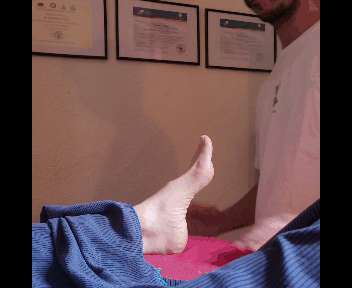Joint mobilisations are manual therapy techniques that improve joint mobility and flexibility and reduce joint pain.
Joint mobilisation can be applied to many body joints.
Some contraindications have to be taken into consideration for mobilisation:
- Joint swelling
- Osteo Arthritis
- Bone Fracture
- Bulge disk (if the mobs are intended on a vertebra)
Mobilisation VS Adjustment.
Mobilisations are different from Chiropractic adjustment.
The difference is that Chiropractic adjustments are fast movements applied with more significant pressure.
Mobilisations are constant slow, repetitive movements applied to the joint.
Along with a Myotherapy treatment, Giovanni would evaluate if mobilisation is the proper treatment for your condition.
For example, mobilisation along the spine is recommended when someone presents with a stiff back in the sacrum, lumbar, thoracic or lower cervical area.
Giovanni would always double-check with you about what the mobs felt like.
Types of Mobilisation.
As we already know, the body is made of different types of joints.
Given the different types of joints, like socket joints, plane joints and more, others are the type of mobilisation.
For example:
For a joint like the hip, we can apply mobility like a distraction, anterior-to-posterior pressure or posterior-to-anterior pull, internal rotation or superior-to-inferior pull.
Some of these techniques can be applied to other joints, and each way of using a mobilisation aims to improve a specific range of motion.
So, all up, the type of mobilisation that we have are:
- Superior to Inferior;
- Inferior to superior;
- Distraction;
- Posterior to Anterior;
- Anterior to Posterior;
- Posterior glide;
- Anterior glide;
- Lateral glide;
- Medial glide.
Mobilisation Belt.
![]()
A mobilisation belt can be used to deliver the mobilisation based on the joint we aim to work on.
A belt is a tool wrapped around the designated joint we want to work on and is used to apply stretches that would not be as easy to achieve by hand.
An example is a hip distraction. For distraction, we refer to it as a force that pulls a joint apart.
In the case of a hip, the head of the femur is pulled away from the hip’s socket from the medial to the lateral direction.
As you would imagine, using bare hands for applying this technique not only could result in an uncomfortable approach to the intimacy of the patient, but it would requireFr too much effort for the therapist, resulting in poor mobilisation delivery and risk of injury.
Therefore, the best tool is a belt wrapped around the patient’s hip and the therapist’s waist.
Why use the mobilisation technique?
The mobilisation technique aims not to reproduce pain, cracking sound, or sharp sensation.
Indeed, the aim is to reproduce a firm pressure/pull on the joint area.
Regarding the thoracic area, if any of those vertebrae reproduce pain or sharp sensation, applying the mobs along the vertebrae/ribs joint would be better.
Doing so would still possible to affect spine mobility indirectly.
Giovanni’s training for this type of modality started during the Advance Diploma in Myotherapy at RMIT and continued at the Bachelor of Health Science at Torrens University.
Mobilisations technique can be applied to Big Toe, Ankle, Shoulder, Feet, Hip, Wrist, Elbow, Vertebrae, SIJ joint, Facet Joint, Clavicle and other body areas.
An example of joint mobilisation for the feet.
Mobilisations at the ankle area are used for improving ankle mobility.

Indeed, improving ankle mobility is to better support during the walk, standing and or running.
Always talking about the feet area, the mobilisation applied to the Big Toes is used along the Metatasolphalangeal Joint.
Do you feel your joints stiff? Your booking for a Myotherapy treatment with Giovanni is just a click away.
This mobilisation is applied by creating a distraction movement within the joint, pulling the toes away and then using it for passive flexion and extension.
As mentioned in another blog post about wearing bear foot shoes, the Big toes are meant to extend from 65° to 70°.
Conclusion
The Big Toes are the feet joint that should push the most in the feet strike as we walk.
In conclusion, mobilisations are a great way to increase mobility within a joint allowing better movement and improving the range of motion.